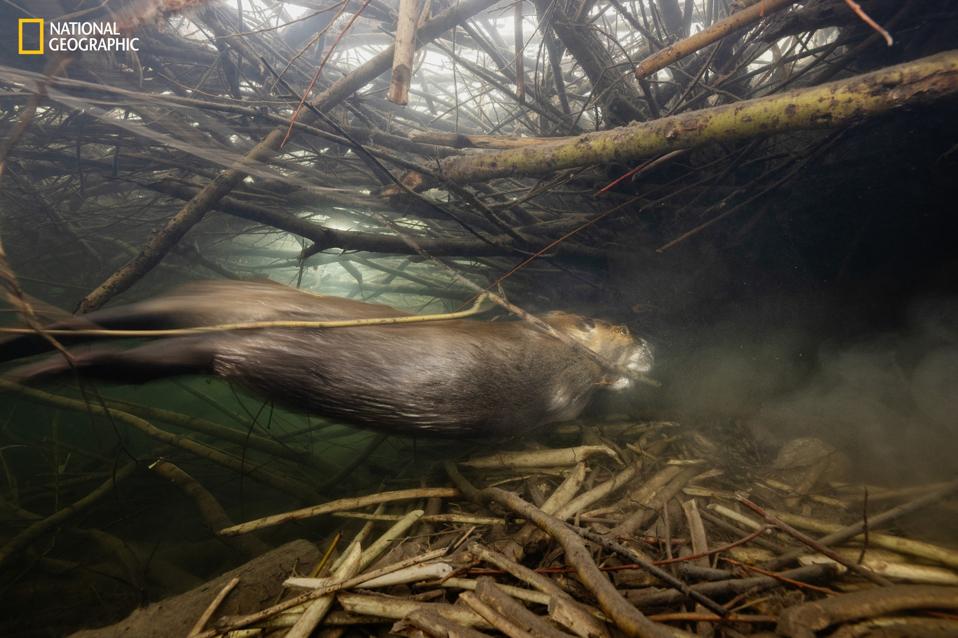The most remarkable image in National Geographic’s upcoming feature isn’t what you might expect. It’s not a lion on the savannah or a polar bear on retreating ice. It’s a beaver—swimming beneath a frozen pond. A single shot, years in the making, quietly captures one of the most important comeback stories in North American ecology.
To get it, photographer Ronan Donovan and photo engineer Tom O’Brien had to build a custom underwater camera rig, designed to function beneath ice in shallow, silty water. “Shooting underwater is hard enough,” said O’Brien. “Shooting under the ice is even harder. Ronan had to photograph beavers in their habitat, near their dens, which raised so many issues—from silt being disturbed to keeping all the equipment powered for long periods in freezing temperatures. Everything had to be robust, waterproof, and reconfigurable.”
The result: a breathtaking view few humans have ever seen—and a visual symbol of a species that may hold the key to environmental resilience.
From Pest to Partner
Beavers were once everywhere across North America. Then came the fur trade. Hunted nearly to extinction for their pelts, they were later branded a nuisance for flooding farmland and chewing through timber. By the early 20th century, their numbers had dropped dramatically. But today, they’re back—10 to 15 million of them, according to recent estimates.
And now, they’re being recognized not as pests, but as partners in ecological repair.
Beavers build dams. That much is well known. But those dams do more than create ponds. They slow the flow of water, reduce erosion, and replenish groundwater. They create habitats for fish, amphibians, birds, and other mammals. They reshape entire ecosystems, often in ways that benefit humans too.
Beavers and the Battle Against Wildfire
One of the most compelling aspects of the beaver resurgence is their growing role in wildfire resilience. Emily Fairfax, an ecohydrologist now at the University of Minnesota, has studied how landscapes influenced by beaver activity behave during wildfires. Her peer-reviewed study, “Smokey the Beaver,” published in Ecological Applications in 2020, found that beaver ponds and canals help irrigate the land, transforming typically flammable terrain into green, moist zones that resist ignition.
Fairfax’s research examined satellite data across multiple fire events in the western United States from 2000 to 2018. The evidence suggested that areas shaped by beaver engineering consistently stayed greener and cooler during wildfires, providing natural refuge for wildlife and livestock.
These findings were tested further during the 2020 East Troublesome Fire in Colorado—one of the largest in the state’s history. When Fairfax later surveyed the scorched region, she observed that the lush corridors maintained by beaver dams had endured even as surrounding forests were decimated. These wetland pockets didn’t just survive—they actively helped mitigate the impact of megafires fueled by climate change.
Her work illustrates a growing understanding in the scientific community: the way beavers manage water and shape vegetation isn’t just ecologically valuable—it could be essential in an era of more extreme and frequent wildfires.
Nature’s Engineers in a Warming World
As climate change reshapes the landscape, beavers are adapting—and helping us adapt in return.
In the American West, where snowpack levels are dropping, beaver dams hold water in the landscape longer. They mimic the function of natural reservoirs, easing the impact of drought. A growing number of states are investing in beaver restoration programs, seeing the species as a low-cost, high-impact solution to water scarcity and ecosystem degradation.
In Alaska and Canada, beavers are pushing north, moving into tundra regions where warmer temperatures have made new territory accessible. While their expansion into the Arctic brings new ecological questions, it also shows their remarkable resilience.
And in cities like New York, they’re even staging urban comebacks. Beavers have recolonized parts of the Bronx River and Staten Island, building dams and carving wetlands in places once written off as lost to development.
Seeing Beavers from Space
Technology is now helping us see the full impact of these animals—literally. Satellite imagery is being used to map beaver activity across landscapes, tracking how their dam-building behavior shapes the flow of rivers and the spread of vegetation. This kind of data is helping scientists understand how wildlife can support climate adaptation at scale.
That brings us back to Donovan’s image. It’s more than a technical feat. It’s a visual cue that reminds us to look deeper—beneath the ice, beneath the surface of conventional narratives.
A Photo, a Species, a Second Chance
There’s a quiet power in this photo. It captures a moment, but it also captures a movement—one that’s been building for decades and now finds its place in a warming, fire-prone world.
Beavers aren’t a silver bullet. But their return shows what’s possible when we work with nature instead of against it. Their dams are blueprints for resilience.
As fire seasons lengthen and water becomes more precious, it’s worth asking: What if the best solutions aren’t always new? What if, sometimes, the answer is a tail-slap in a frozen pond?
Nat Geo’s beaver feature—headlined by Donovan’s rare under-ice photo—reminds us that sometimes environmental allies are hiding in plain sight. The full piece debuts in the June 2025 issue.
Keep an eye out for the image. But more importantly, keep an eye out for the beavers.

